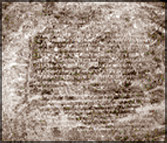Mahavamsa, the great chronicle
How many times have you come across the phrase “according to the
Mahavamsa” when reading articles about historic places and historic
incidents? Have you ever wondered what this book is and why it is so
important? The Mahavamsa is also known as Mahavamsa or the great
chronicle. Today, we are going to take a closer look at the Mahavamsa,
the great chronicle.
|

A stone inscription |
The Mahavamsa is a historical poem written in the Pali language. It
describes the kings of Sri Lanka. It covers the period from the arrival
of King Vijaya of Kalinga (ancient Orissain India) in 543 BC to the
reign of King Mahasena (334 - 361).
The first printed edition and English translation of the Mahavamsa
was published in 1837 by George Turnour, a historian and officer of the
Ceylon Civil Service.
A German translation of Mahavamsa was completed by Wilhelm Geiger in
1912. The Mahavamsa is not actually a religious text; it is an important
Buddhist document because it covers the early history of religion in Sri
Lanka.
Every chapter of the Mahavamsa ends with the statement that it is
written for the “serene joy of the pious”. Buddhist monks of the
Mahavihara maintained chronicles of Sri Lankan history, starting from
the Third Century BC. These records were combined and compiled into a
single document in the Fifth Century CE by the Buddhist monk Mahathera
Mahanama.
 There is evidence, according to Wilhelm Geiger, that there was
another compilation prior to this, known as Mahavamsa Atthakatha, and
that Mahathera Mahanama relied on this text. Another earlier document
known as the Dipavamsa that survives today, is much simpler and contains
less information than the Mahavamsa, and was probably compiled using the
Mahavamsa Atthakatha as well. There is evidence, according to Wilhelm Geiger, that there was
another compilation prior to this, known as Mahavamsa Atthakatha, and
that Mahathera Mahanama relied on this text. Another earlier document
known as the Dipavamsa that survives today, is much simpler and contains
less information than the Mahavamsa, and was probably compiled using the
Mahavamsa Atthakatha as well.
|

A German translation of Mahavamsa was completed by Wilhelm
Geiger. |
A companion volume, the Chulavamsa (“lesser chronicle”), compiled by
Sinhalese Buddhist monks, covers the period from the Fourth Century to
the British takeover of Sri Lanka in 1815. Chulavamsa was compiled by a
number of authors of different time periods.
The combined work, sometimes collectively referred to as the
Mahavamsa, provides a continuous historical record of over two
millennia, and could be considered as one of the world’s longest
unbroken historical accounts.
The historical accuracy of the document, given the time when it was
written, is considered to be astonishing, although the material prior to
the death of Asoka is not trustworthy and mostly legend. However, that
part of the Mahavamsa is one of the (rare) documents containing material
relating to the Nagas and Yakkhas, the dwellers of Lanka prior to the
legendary arrival of Vijaya.
As it often refers to the royal dynasties of India, the Mahavamsa is
also valuable for historians who wish to date and relate contemporary
royal periods in the Indian subcontinent.
The accounts given in the Mahavamsa are also thoroughly supported by
the numerous stone inscriptions, mostly in Sinhalese, found in the
Island.
Modern historians like Karthigesu Indrapala have also upheld the
historical value of the Mahavamsa. If not for the Mahavamsa, the story
behind the large stupas (shrines) in Anuradhapura, such as Ruwanweliseya,
Jetavanaramaya, Abhayagiri, and the ancient engineering works would
never have been known.
|

The chronicle covers the early history of religion in Sri Lanka |
Besides being an important historical source, it is the most
important epic poem in the Pali language. Its stories of battles and
invasions, court intrigue, great constructions of stupas and water
reservoirs, written in elegant verse suitable for memorisation, caught
the imagination of the Buddhist world of the time. The engineering works
of King Parakramabahu were the greatest hydraulic works in the world in
those times.
Unlike many texts written in antiquity, it also discusses various
aspects of the lives of ordinary people (see Chapter XXIII- XXVIII), how
they joined the King’s army or farmed.
Thus the Mahavamsa was taken along the silk route to many Buddhist
lands. Parts of it were translated and retold and absorbed into other
languages. The Mahavamsa gave rise to many other Pali works of the
chronicle genre (type), making Sri Lanka of that period probably the
leading world centre in Pali literature.
Compiled by Janani Amarasekera
|
